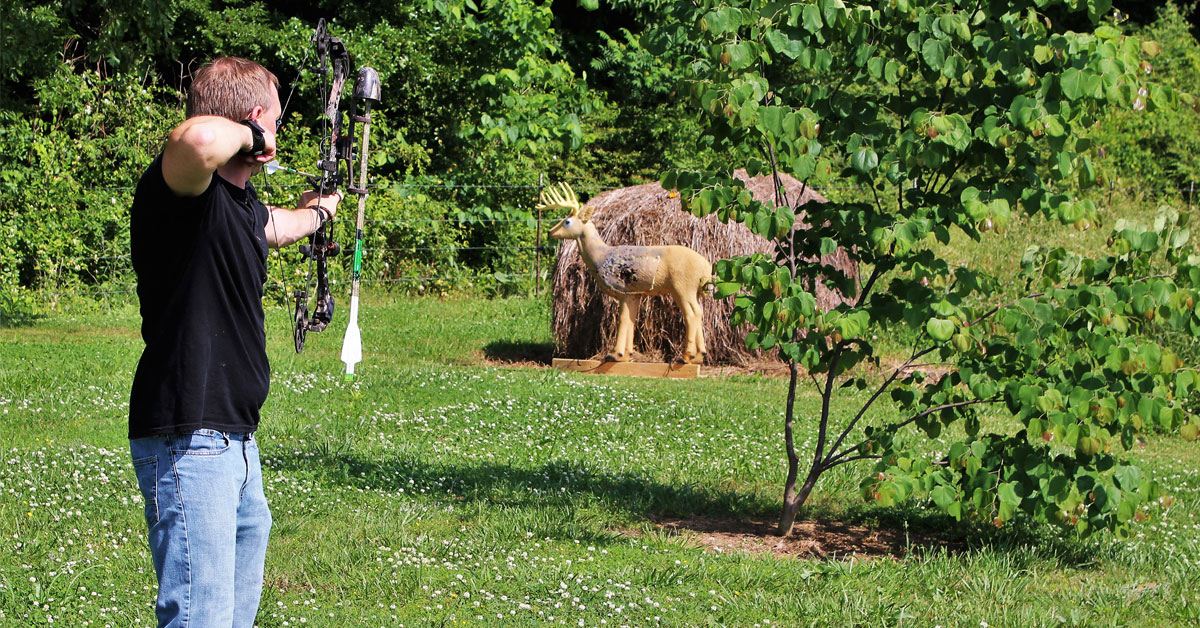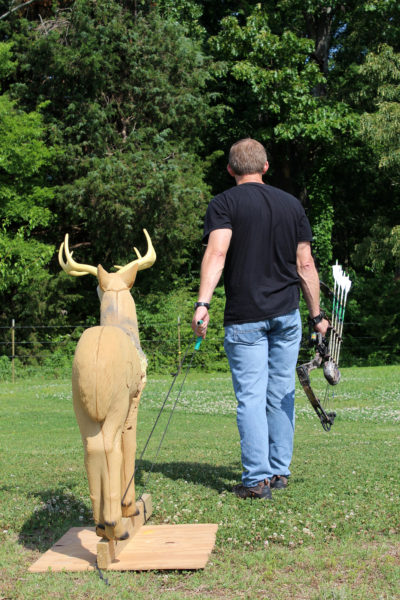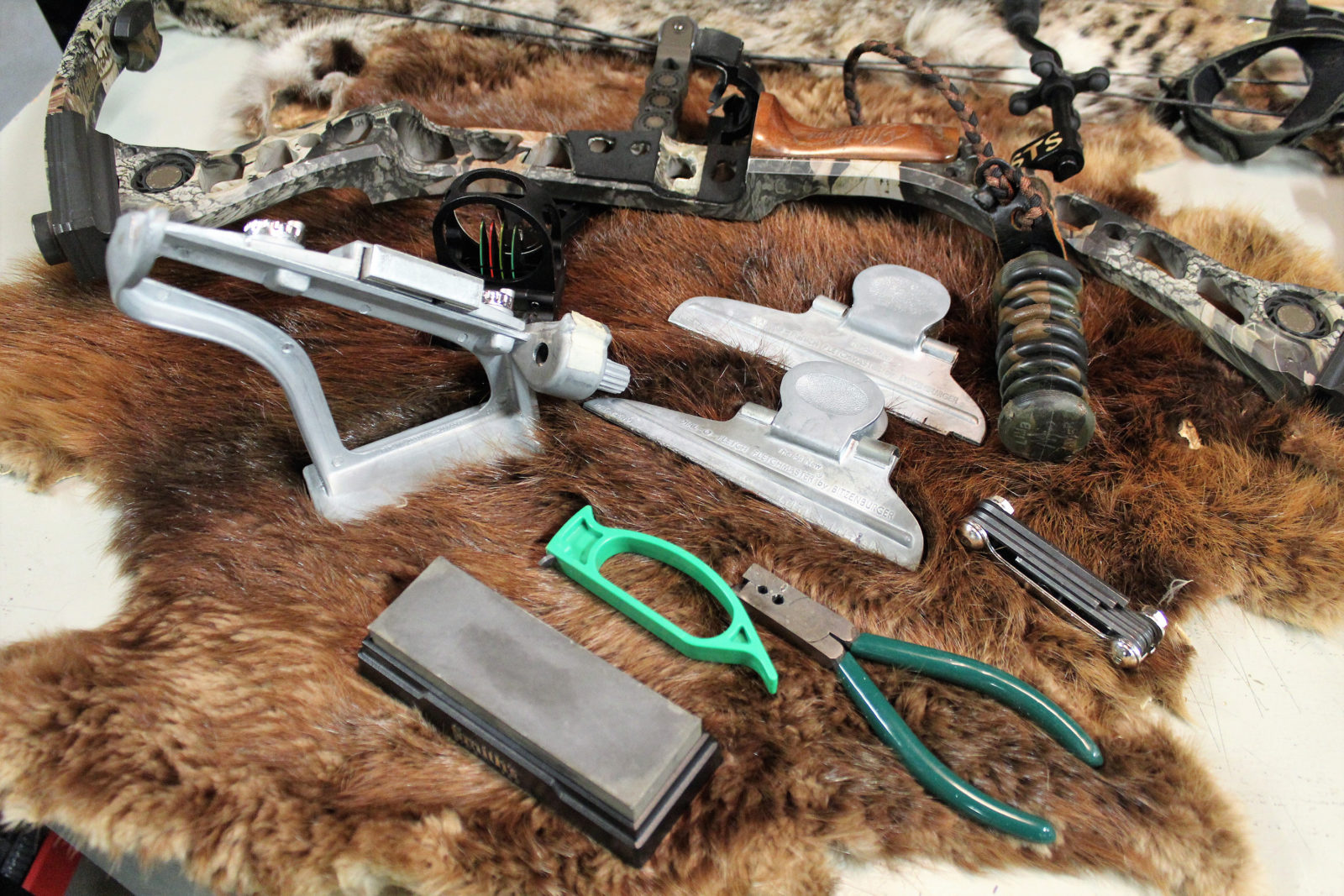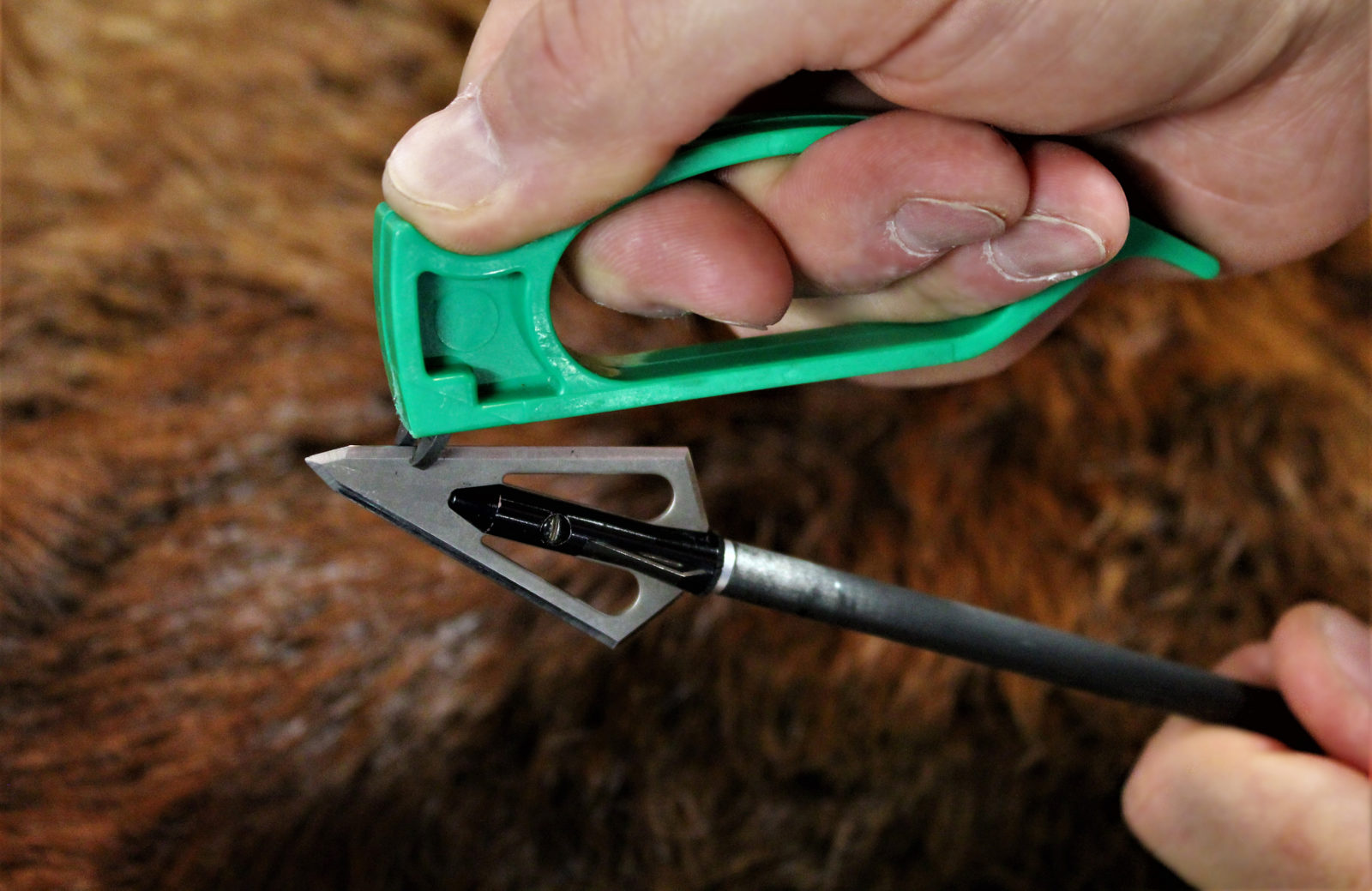Hunting whitetails at close range with archery tackle is a tall order. However, pre-season planning and practice can be a defining factor!

Don’t forget the best hope for a lethal arrow is shot location. When arrow/bow set-up is important - off season practice helps ensure those arrows hit where needed.
By Matt Green
Photos by Matt Green
Tags punched, my friend BJ rested on stand above me, video camera in hand. I had trekked to his home in Kentucky, for a holiday hunt with my comrade. BJ had predicted some does would feed through mid-afternoon and not long after settling in, a pair drifted through, presenting a 30-yard shot. However, the deer’s current path would bring them within 12 yards, and I had recently resolved to be more patient. With the wind in my favor, I waited.
Moments passed and as the pair neared, I drew. We didn’t know it, but a lone doe had emerged behind us, 40 yards downwind and she was wise to us. The hidden doe blew, just as I came to full draw, likely having coupled my movement with human scent. Alerted, the pair in my shooting lane darted. As they faded into the timber, the younger of the two paused broadside on their exit route. I loosed an arrow. She bucked once and 40 yards later I watched her go down. While no tracking was necessary, I was eager to inspect the blood trail.
Profuse bleeding confirmed that perfect hit. This trail prompted me to reflect in general how death occurs in an arrowed deer. A few years earlier, a colleague and I had concluded that all deer die of insufficient oxygen delivery. This can occur in multiple ways, but how do we as hunters try to make this happen? And most importantly, what components prove most critical as we try to make quick, humane bow kills?
Basic Physiology
Without life-sustaining oxygen, death is imminent. Oxygen is delivered by the blood. Insufficient oxygen in tissue is known as hypoxia. Hypoxia can occur if the blood being delivered has insufficient oxygen or if the total amount of blood delivered is inadequate. As bowhunters, we attempt to cause profuse blood loss such that the brain receives inadequate blood flow and therefore inadequate oxygen. The brain then becomes hypoxic, and our quarry expires. This sounds easy enough. And most bowhunters are aware of this basic objective. Understanding some of the science behind the function of blood may help you successfully harvest the next animal you find in your sights.

3D targets are great, especially for creating more realistic shot situations. Be creative and make your target portable. This allows you to shoot from multiple different angles and locations. 3D targets can be stored in the garage or basement away from the outside elements and greatly extend your target life.
Under normal conditions, air enters the lungs and oxygen is loaded into the blood. The heart then pumps the oxygen-rich blood to the body through arteries. Therefore, for effective blood delivery the deer needs the heart (the pump), lungs and delivery system (arteries and veins). Damage to any component impairs the function of the entire system. Because all of the animal’s blood flows through the lungs, and that is where oxygen is loaded, the lungs are an ideal target. The lungs also offer the largest target critical to oxygen delivery.
Oxygen delivery occurs in a closed system. That means red blood cells which transport the oxygen do not leak from the system. However, puncturing a lung or severing an artery creates leaks. If severe enough and the damage can’t be repaired quickly, the animal will be unable to recover. Many bowhunters have shot an animal but suffered the disappointment of loss of the animal. Let’s examine some of the potential explanations.
Arrow Penetration
The function of an arrow is cutting via the broadhead. Technology and arrow and broadhead design have aided in the development of highly lethal weapons. However, inadequate penetration can occur, and this significantly impairs intended function. Many factors affect penetration. Impacting bone such as the shoulder blade, for example, can slow or impede penetration. Broadheads with a chisel tip are touted as being the most effective for punching through bone. However, aiming to avoid impact with the shoulder is the best approach. This requires knowledge of deer anatomy.
Poor tuning can impair penetration. If an arrow fishtails or porpoises, it may impact less than straight-on, which quickly reduces the energy for driving in the broadhead. Likewise, the straighter the arrow hits the animal, the better the penetration. Impact at 90 degrees to the target is ideal, which requires a well-tuned setup.
Some believe heavier arrows offer an advantage for penetration. I had a traditional archer once ask me whether a Ping-Pong ball or golf ball would be easier to throw through a snow bank. Good illustration, but would you rather throw a baseball or a bowling ball across home plate? The heavier the arrow, the more energy, but the slower the arrow, the less energy. So, there is always a tradeoff! At short range, a heavy arrow is best, but a heavier arrow drops faster, so sight pins for multiple distances will be spaced further apart.

Certain gear is essential for ensuring properly tuned, and therefore exceptionally lethal arrows. Building and tuning your own arrows allows you to experiment with what flies best out of your bow.
Traditional archers insist on cut-on-contact broadhead. With slower speeds and lower overall energy (vs. compound bows) these heads help get the arrow into the ‘breadbasket’. Many traditional enthusiasts contend that an arrow with a heavy front of center (foc) improves penetration, and again heavier arrows penetrate better at the same speed. Advantages of different types of heads and arrow set-ups with respect to weight and foc will continue to be heavily debated.
Most modern compound bows create more than enough energy when shot location is good. Therefore, for these bowhunters, the job is to ensure arrow/broadhead setup is well-tuned to generate optimal penetration allowing the broadhead to do its job.
Shot Placement
The key issue to ensure a quick humane harvest, though the most challenging, is good shot placement. Damage from the broadhead has to be severe enough to result in death. Certainly, a direct hit on the heart will result in quick and dramatic blood loss. Hitting the heart with a broadhead fatally damages the pump and therefore blood delivery as well. Another reason this is lethal is that it is impossible to impact the heart without impacting one or both lungs multiplying the blood loss.
Ideal shots don’t always happen. When an animal poses broadside, the patient hunter can more easily pinpoint arrow placement. Also, for broadside shots from the ground, if one lung is impacted, the other is almost guaranteed to be hit because it lies like a shadow behind the near side lung. However, hunting frequently involves less than ideal situations. Shots from an elevated stand or quartering shots pivot the animal’s vitals creating a smaller target. Also, the angle of the arrow path relative to the vitals is changed increasing the likelihood of single lung hits. Single lung hits can be fatal, but usually there is half as much tissue damage as with double lung hits. Considering the anatomy of a deer or similar animal, a hard quartering shot may result in the arrow passing almost from back to front of a single lung. A near straight down shot could likewise slice through a single lung from top to bottom. These would most likely prove fatal. Again, less damage means less blood loss, and less sign to track. If a single lung hit is suspected, it is a good idea to extend wait time before starting recovery.

Fletching and blades alignment: Some are tuned best when blades are aligned with fletching, while others fly better when the blades are aligned between two vanes. Pre-season testing is needed to determine the best approach for your set-up.
Some good advice I have read for quartering shots or those from an elevated stand is to aim at the opposite side shoulder. Another is to shoot toward the center of an imaginary basketball in the middle of the animal’s chest. Also, from a stand, err on the lower (vs. higher) portion of the chest. Of course, we also know that it is critical to practice from elevated positions and on quartering shots, so we know our equipment and can put the arrow where we want.
Sharp Broadheads
The final component for arrow lethality is broadhead sharpness. Bowhunters are often obsessive in this regard. I tend to lean this direction and for good reason. Bowhunters depend on blood loss for successful, ethical harvests. In a miracle of good design, when leaks in the blood delivery system develop, the blood is designed to clot in order to slow and stop blood loss. Without the clotting mechanism, even minor cuts or scrapes would result in death. Consideration of the response to tissue damage reassures us of the importance of razor sharp broadheads.
When vessels are cut or damaged, the clotting process begins immediately. The first step in deterring blood loss is called vascular spasm, which is a constriction of the cut vessel. Constriction reduces vessel radius and therefore slows leakage. The sides of the constricted vessel may stick together and further slow blood loss until platelets gather and clotting occurs. Almost simultaneous with vascular spasm, platelets are activated. Activated platelets cling to the damaged portions of the vessel. An enzyme (thrombin) speeds clot formation. The clotting process is linked to the amount of damage to the specific vessel. A razor cut on a vessel is smooth and offers less area for platelets to collect to form the clot compared to one that was cut with a dull instrument. Compare a nick when shaving to one from a nail. Though smaller, the razor cut takes a long time to clot compared to the rough scratch. This is largely because a rough surface (the scratch) offers platelets a better place to form a clot. Because we want to reduce clotting for our deer, sharp broadheads are paramount. Think again about the single lung hit. If cut with a razor sharp broadhead, the clotting is slower, and the single lung hit is more likely to be fatal.

Broadheads should never be less than shaving sharp – a must! This minimizes the clotting process and thus maximizes blood loss!
The ability of the vascular system to repair itself is impressive. Depending on the nature of the damage, clotting may be complete in three to six minutes. Stories abound of deer which sustained major wounds and still recovered. A deer’s ability to survive a broadhead is far superior to ours.
Prepare for the Best
Many of us choose to hunt with bow and arrow due to the added challenge. It’s no secret the animals we pursue are tough. In the Oakmulgee management area near Tuscaloosa, Alabama, I arrowed a mature whitetail doe right after she walked under my tree. The shot was quartering and she was still very close. The angle of the shot resulted in an exit wound near her sternum. On inspection, I found the arrow had passed through the center of the heart. She still ran about 70 yards before collapsing. Many hunters can recount stories of miles of blood trails with no recovery. The amazing resilience of animals is due in part to the ability of the vascular system to sustain and repair damage. Understanding how it works reminds us why attention to detail in our equipment and careful shot placement can make or break a hunt.
Hunt long enough and errant shots are inevitable regardless of how well-prepared, careful and patient we may be. Whitetails and other game are not only wary but extremely tough. While marginal shots are sometimes fatal, odds improve when broadheads are sharp, bows/arrows are well-tuned and shot placement is ideal. As hunters, we strive to respect our quarry to ensure quick humane kills. Experienced hunters are typically aware of the factors critical to killing shots: Arrow penetration, shot location and a sharp broadhead. Killing a whitetail is tough enough, but some good planning and practice tip the odds in our favor.
Editor’s note: Matt Green is a professor of Exercise Science and department head at the University of North Alabama. While he teaches and conducts research in exercise physiology, he is an avid deer hunter. In addition to publishing in scientific journals, he enjoys writing about whitetailed deer and hunting in general. He combines his enjoyment of traditional archery with his draw to the woods and often hunts with a recurve bow. Matt lives on a small farm just outside Rogersville, Alabama, with his wife Staci, daughter Summer (11) and son Case (6). Readers can contact him via email at jmgreen@una.edu.
©Virginia Deer Hunters Association. For attribution information and reprint rights, contact Denny Quaiff, Executive Director, VDHA.



